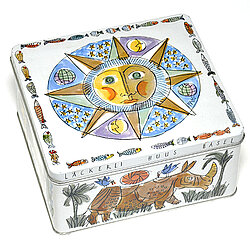History of the biscuit tin
Thomas Huntley opens a bakery in Reading / England. His baked goods become so popular that he is confronted with the challenge of transporting his delicate goods undamaged to other places as well. His brother, an iron and coppersmith, comes up with a solution: he creates a container made from wood and iron sheet. Later, the iron sheet is coated with tin and thus the tin-plated biscuit tin is born.
The business flourishes and in order to keep up with the high demand, Thomas Huntley, together with the engineer George Palmer, automates his business. The biscuits and tins are now produced using machines and over the course of just a few decades the small bakery in Reading has become an industrial empire. The biscuit company Huntley & Palmers is appointed as a purveyor to the British Royal Family and begins to export its baked goods worldwide.
Right from the very beginning, André Klein, the founder of what is today Läckerli Huus, uses decorative tins as packaging for his confectionery specialities, and they also serve as a practical and inexpensive advertising medium.
André Klein soon begins to specialise in the production of Basler Läckerli, as well as a range of other delicacies. This proves to be a great success. After only a few years he builds an automated production facility in the former Sarasin & Heusler cotton mill in Münchenstein.
After the Second World War, tinplate lost its appeal as a packaging material and old tins were thrown away. André Klein’s successor Robert Klein recognised the value of such attractive packagings: the Klein family collected over 2000 biscuit tins from all parts of the world over the course of two generations.
Läckerli Huus continues to regard tins as the ideal household container for Basler Läckerli Original as well as packaging for high-quality, attractive gifts. Robert Klein is able to get renowned graphic designers such as Donald Brun and Celestino Piatti, as well as other artists to design biscuit tins and papier-mâché eggs.
Introduction of themed tins with special shapes such as transport vehicles, buildings or musical instruments which, over the years, have become established as "collector’s tins":
- 1983: "Camionetta" lorry
- 1991: "Circus Knie" lorry
- 2001: "Uri" steamer
- 2003: "Steam Locomotive" tin
- 2007: "Elephant" tram tin
- 2008: "Dante Schuggi" tram tin
- 2009: Street organ tin
- 2010: Green "Crocodile" locomotive tin
- 2011: The "Carousel" musical tin
- 2012: Jass tin
- 2013: "Tango" musical tin
- 2014: "Postauto" tin
Continuing the established tradition of creating special, artist-designed tins, Läckerli Huus introduces an annual, limited edition of "artist's tins", which pay homage to the works of each artist:
- 2006: "Monet" Fondation Beyeler and Läckerli Huus
- 2008: "Miro" Fondation Beyeler and Läckerli Huus
- 2009: "Van Gogh" (2 tins), Art Museum Basel and Läckerli Huus
- 2010: "Anker" (2 tins), Museum of Fine Arts Bern and Läckerli Huus
- 2011: "Tinguely" (2 tins), Museum Tinguely Basel and Läckerli Huus
- 2012: "Hodler" (2 tins)
- 2013: "Picasso" (2 tins), Art Museum Basel and Läckerli Huus
- 2014: "Koller", Kunsthaus Zürich and Läckerli Huus
Läckerli Huus has remained true to its traditions. Tins in a variety of different colours and shapes still represent an important packaging for gifts from Läckerli Huus.
Tins that generally change their theme each year:
- Carnival, Easter and Christmas tins
- Collector’s and artist's tins
- "Kaffikränzli" tin filled with wafers
- "Gold" tin, filled with finest Läckerli Huus specialities















